Groove Turning | |||||
|
| ||||
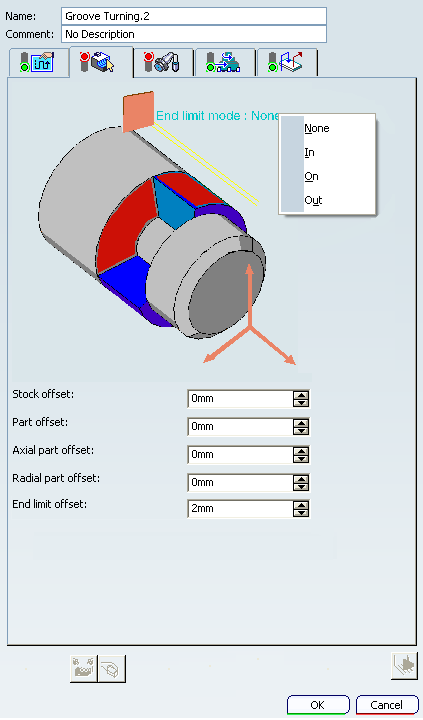
Strategy Parameters
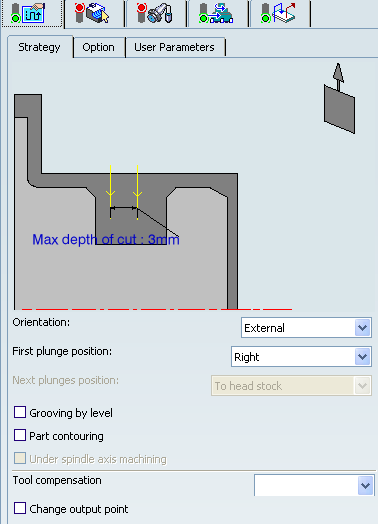
- Tool Axis
- See Defining the Tool Axis
- Orientation
-
Specifies
the orientation of the groove to be machined as:
The selected orientation defines the type of geometric relimitation to be done between the stock and part geometry in order to determine the area to machine.
- First Plunge Position
- Specifies a first plunge position depending on the groove orientation. You can specify:
- Right, Center, or Left for Internal orientation.
- Right, Center, or Left for External orientation.
- Up, Center, Down, or Automatic for Frontal orientation.
The position of the first plunge for Automatic is deduced from the minimum and maximum cut diameters of tool. The position is calculated as: (Minimum cut radius + Maximum cut radius)/2.
- Right of Groove, Left of Groove, Center for Other orientation.
- Next Plunges Position
- Specifies a next plunge position.
This option is activated when First Plunge Position is set to Center. You can specify:
- To Head Stock, From Head Stock, or Single Plunge for Internal orientation.
- To Head Stock, From Head Stock, or Single Plunge for External orientation.
- To Spindle, From Spindle, or Single Plunge for Frontal orientation.
- Right of Groove, Left of Groove, or Single Plunge for Other orientation.
Next Plunges Position is suitable for machining a narrow groove, possibly using the Grooving by level and Chip break options. In the Single plunge case, Part Contouring is not available.
- Grooving by Level
- Select this check box to machine the groove in one or more levels.
Multiple-levels mode is particularly useful when the groove is too deep
to machine in one level.
In this case Max depth of level defines the maximum depth of each level. If it is greater than the Maximum depth of cut defined on the tool, the value on the tool is taken into account. During return motion at the end of a level, the tool returns at Rapid or Air-cutting feedrate to the first pass of a new grooving level up to a Max approach distance. The feedrate then reduces to lead-in feedrate for this approach distance.
- Part Contouring
- Select the check box if contouring is required. This option allows you to request machining
under the spindle axis, when orientation is in frontal mode.
The part profile is followed at the end of grooving. This is done by machining down the sides of the groove in order to clear the profile. Part Contouring is done based on collision checking between the tool insert and stock/part profiles. This means the contouring path which is collision free, may lead to incomplete part contouring based on the geometry of the stock and part profile selected during geometry definition. To get complete Part Contouring, geometry of the stock and part profile selected during geometry definition must account for any collisions between tool insert and geometry.
- Under Spindle Axis Machining
- This allows to request machining under the spindle axis. This option is available when Orientation is in Frontal mode.
- Tool Compensation
- Select a tool compensation number
corresponding to the desired tool output point.
The usable compensation numbers are defined on the tool assembly linked to the machining operation.
 By default,
the output point corresponding to type P9 can be used, if you do not select a tool compensation
number.
By default,
the output point corresponding to type P9 can be used, if you do not select a tool compensation
number. - Change Output Point
- Set the
Change Output Point check box to automatically manage the change of output point.
If the output point is consistent with the flank of the groove to be machined, the output point is changed when the other flank of the groove is machined. At the end of the Machining Operation, the output point is the same as it was at the start of the Machining Operation. See Tool Output Point Change.
- Max Depth of Cut
- Specifies the maximum distance between plunges.
![]()
Strategy: Option Parameters

- Gouging Safety Angle
- Angle attributes on the grooving insert are taken into account to avoid
collision by reducing the maximum slope on which the tool can machine. The
Gouging Safety Angle allows you to further reduce this slope.
A gouging angle can also be defined on the insert-holder to define the maximum slope on which the tool can machine. In this case and if the Insert-Holder Constraints setting is applied, the angle that reduces the slope the most can be taken into account.
- Insert-holder constraints
- Specifies insert-holder constraints as:
- Ignore
- Apply
The following attributes (located on the Insert-holder's Technology tab) may influence machining: See Creating or Editing a Probing, a Milling, or a Drilling Tool
- Gouging angle
- Trailing angle
- Leading angle
- Maximum recessing depth
- Maximum cutting depth
- Maximum boring depth
These attributes take tooling accessibility into account and may reduce the machined area.
Note: Use the Insert-Holder Constraints option to either ignore or apply these attributes. You can replay the operation to verify the influence of these attributes on the generated tool path.
- Insert-holder constraints are applied if the sum of tool setup angle and angle of groove incline (if defined) is less than 45 degrees.
- The Insert-holder constraints setting does not influence the Gouging Safety Angle or Max Depth of cut.
- Chip Break
- Select this check box if chip clearing is to be done during machining.
In this case you must specify:
- Chip plunge distance
- Chip break retract distance
- Chip clear distance
- Machining Tolerance
- Specifies the maximum allowed distance between the theoretical and computed tool path.
- Lead-in Distance
- Specifies Lead-in Distance with respect to the cutting direction. It takes the stock profile
and stock clearance into account.
The tool is in RAPID mode before this distance.
- Attack Distance
- Specifies Attack Distance with respect to the cutting direction and the stock profile with
a stock clearance. Once the
attack distance has been run through, the tool moves at machining feedrate.
These options allow penetration into the workpiece at a reduced feedrate in order to prevent tool damage. When tool motion between two passes is in contact with the part profile, in order to avoid collisions the corresponding feed is the lift-off feedrate and not RAPID.
- Lift-off Distance and Lift-off Angle
-
Specifies the Lift-off Distance and Lift-off Angle parameters to define the lift-off vector at the end of each pass with
respect to the cutting direction.
The figure below shows the effect of a positive lift-off angle for external machining.
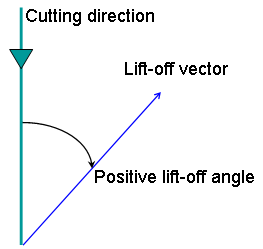
![]()
Geometry
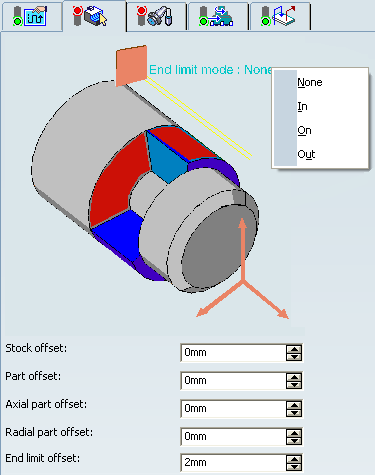
- End Limit Mode
- This option allows you to specify a point, line, curve or face to
relimit or extrapolate the selected part profile.
If a face is specified, the end element is the intersection of the face and the working plane.
You can specify In / On / Out settings for limit modes.
This setting allows you to specify the Go-Go type positioning of the tool with respect to the end element. Go-Go type positioning of tool in general positions the tool based on its radius and tool compensation number. This means positioning can vary for different tool insert geometries with respect to the limit and there is possibility of tool going beyond limit even with In option. The On option is always used for a point type end element.
Use the option End Limit Mode and select the End Re-limiting Element to restrict the tool path with the end element for an open ended Groove. The selected element is highlighted as shown below and the tool path is computed till the end limit element based on the selected End Limit mode (in this case In mode). This generate the new tool path up to the End Re-limiting Element as shown below.

If the end limit is before the end of the geometric element end then the new path should be till the end limit. If the end element is out of the geometric end limit then the new tool path gets extended till the end limit.The End Limit has influence from Strategy tab settings that are specified.
- Case 1: With reference to the above geometry, if you select strategy options as:
- Orientation: External
- First plunge position: Center
- Next plunges position: To head stock
- Case 2: With reference to the above geometry,
if you select strategy options as:
- Orientation: External
- First plunge position: Center
- Next plunges position: From head stock
Note: The old turning operation does not have any end limit in profile geometry and they open up as if the end limit was not set and offsets were not specified. This does not alter the previous tool path even if you recompute the tool path.
- Case 1: With reference to the above geometry, if you select strategy options as:
- Part profile
- Part and stock profiles are required. They can be specified by selecting edges either directly or after selecting the By Curve contextual command in red part area.
- Stock offset
- This is defined perpendicular to the stock profile.
- Part offset
- This is defined perpendicular to the part profile.
- Axial part offset
- This is defined perpendicular to the part profile.
- Radial part offset
- This is defined perpendicular to the part
profile.
Offsets can be positive or negative with any absolute value. The global offset applied to the part profile is the resulting value of the normal, axial, and radial offsets.
- End limit offset
- Specifies the distance with respect to the end element (only if end element is a line or a curve, and when In or Out is set for end element positioning).
![]()
Tools
You can specify external, internal, frontal, or inclined machining according to the type of area to machine. The following tooling may be used:
- Internal
 , External
, External  , and Frontal Groove
, and Frontal Groove  insert-holders with groove
insert-holders with groove
 and trigon
and trigon  inserts.
inserts. For more information about tooling configuration, please refer to the Trigon Insert Used on a Groove Insert-holder.
- External
 and Internal
and Internal  insert-holders with round
insert-holders with round  inserts.
inserts.
See Specifying a Tool Element in a Machining Operation and Creating or Editing a Probing, a Milling, or a Drilling Tool.
![]()
Feedrates and Spindle Speed Parameters
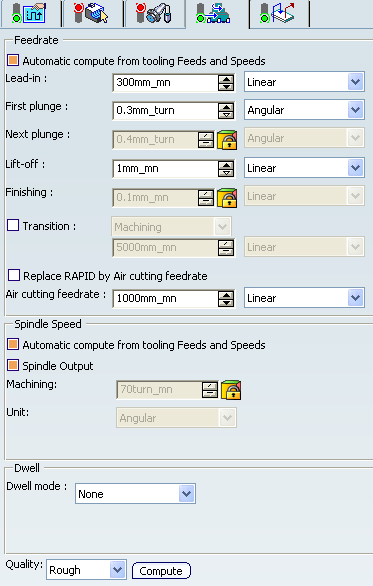
- Feedrate: Automatic compute from tooling Feeds and Speeds
- This check box allow a Machining Operation feeds and speeds values to be updated automatically when the tool's feeds and speeds values are modified.
You can specify the following feedrates:
- Lead-in: This feedrate is applied during lead-in and attack distances.
- First Plunge Feedrate and Next Plunges Feedrate: Different feedrates can be assigned to the first plunge and the following plunges.
- Lift-off : This feedrate is applied during lead-off distance.
- Finishing
- Transition
- You can locally set the feedrate for a transition path to a
Machining Operation B from a Machining Operation A or from a tool
change activity. This is done by selecting the Transition check box in the Machining Operation dialog box for
operation B.
For more information, please refer to the Setting a Transition Feedrate.
- Replace RAPID by Air cutting feedrate
- Select this check box to replace RAPID feedrate in tool trajectories (except
in macros) by Air cutting feedrate.
The changes in unit of Air cutting feed-rate, are also reflected in APT file output. Calculated cycle time in Properties dialog box of Machining Operation also get changed. There are changes in total time and machining time on Tool Path Replay dialog box.
Note:
The feedrates and Air cutting feedrate can be defined in linear (feed per minute) or angular (feed per revolution) units.
- Angular: feedrate in revolutions per minute and unit is set to mm_turn.
- Linear: feedrate in feed per minute and unit is set to mm_mn.
- Spindle Speed: Automatic compute from tooling Feeds and Speeds
This check box allow a Machining Operation feeds and speeds values to be updated automatically when the tool's feeds and speeds values are modified.
If the Feedrate Automatic compute check box is selected and the Spindle Speed: Automatic compute from tooling Feeds and Speeds check box is not selected, then only the feedrate values can be computed. If both are not selected then automatic updating is not done.
When you modify a tool's feeds and speeds, all existing Machining Operations with the Automatic compute checkboxes selected that use this tool (or an assembly using this tool) can be recomputed.
- Spindle output
- This check box manage output
of the SPINDL instruction in the generated NC data file. The instruction is generated, if the check box is selected. Otherwise,
it is not generated
Note:
The spindle speed can be defined in linear (length per minute) or angular (length per revolution) units.
- Angular: length in revolutions per minute and unit is set to mm_turn.
- Linear: length in feed per minute and unit is set to mm_mn.
- Dwell mode
- Dwell setting
indicates whether the tool dwell at the end of each path is to be set in
seconds or a number of spindle revolutions.
Decimal values can be used for the number of revolutions. For example, when machining big parts that have a large volume, it can be useful to specify a dwell using a value of less than one revolution (0.25, for example).
- Quality
- The feed and speed values are computed according to the Quality setting on the Machining Operation.
- Compute
- Feeds and speeds of the Machining Operation can be updated according to tooling feeds and speeds by clicking the Compute button.
Feeds and speeds of the Machining Operation can be updated automatically according to tooling data and the rough or finish quality of the Machining Operation. See About Feeds and Speeds.
![]()
Macro Paramaters

The selected macro type (Approach or Retract) defines the tool motion before
or after machining:
- Approach: to approach the Machining Operation start point.
- Retract: to retract from the Machining Operation end point.
- Linking Retract/Approach: Linking macros, which comprise retract and approach motion can also be used on Groove Turning operations. Approach and retract motions of linking macros are interruptible. For Groove Turning only, you can interrupt the macro at the end of the number of specified levels. See Interruptible Macros
The proposed macro mode are:
- None
- Build by user
- Direct
- Radial-axial
- Axial-radial
It can be useful to interrupt a Machining Operation when the foreseeable lifetime of the insert is not long enough to complete the machining. See Defining Macros.
- Behavior of Linking Macro when Grooving by Level
Groove turning can be done in one or more levels using the Grooving by Level mode. Also, you can define Linking macros and define interrupt modes of these macros.
The macro returns to the next cutting position in the tool path after retract from interruption at the end of a level.
A Linking macro returning to previous tool position and then moving to the next cutting position is considered a redundant move. Such redundant moves are avoided.